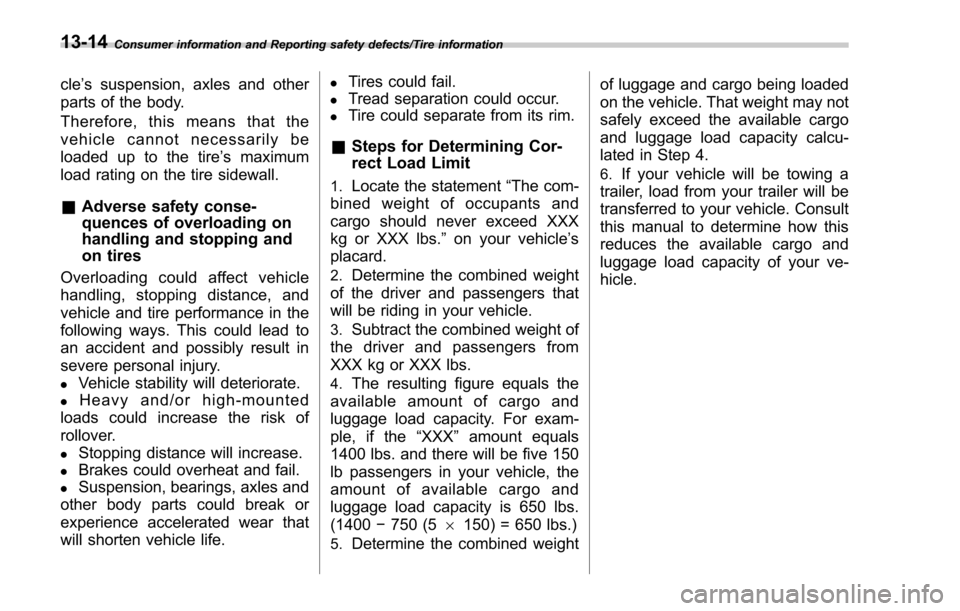Page 611 of 634
Consumer information and Reporting safety defects/Tire information
2.Calculate the available load ca-
pacity.
3.The total weight now exceeds
the capacity weight by 92 lbs (42
kg), so the cargo weight must be
reduced by 92 lbs (42 kg) or more.
Example 2A
Vehicle capacity weight of the
vehicle is 900 lbs (408 kg), which
is indicated on the vehicle placard with the statement
“The combined
weight of occupants and cargo
should never exceed 408 kg or
900 lbs ”.
For example, the vehicle has one
occupant weighing 165 lbs (75 kg)
plus cargo weighing 375 lbs (170
kg). In addition, the vehicle is fitted
with a trailer hitch weighing 22 lbs
(10 kg), to which is attached a
trailer weighing 1,764 lbs (800 kg).
10% of the trailer weight is applied
to the trailer tongue (i.e. Tongue
load = 176 lbs (80 kg)).
1.Calculate the total weight.
2.Calculate the available load ca-
pacity.
3.The result of step 2 shows that a
further 162 lbs (73 kg) of cargo can
be carried.
13-12
Page 613 of 634

Consumer information and Reporting safety defects/Tire information
cle’s suspension, axles and other
parts of the body.
Therefore, this means that the
vehicle cannot necessarily be
loaded up to the tire ’s maximum
load rating on the tire sidewall.
& Adverse safety conse-
quences of overloading on
handling and stopping and
on tires
Overloading could affect vehicle
handling, stopping distance, and
vehicle and tire performance in the
following ways. This could lead to
an accident and possibly result in
severe personal injury.
.Vehicle stability will deteriorate.
.Heavy and/or high-mounted
loads could increase the risk of
rollover.
.Stopping distance will increase.
.Brakes could overheat and fail.
.Suspension, bearings, axles and
other body parts could break or
experience accelerated wear that
will shorten vehicle life.
.Tires could fail.
.Tread separation could occur.
.Tire could separate from its rim.
& Steps for Determining Cor-
rect Load Limit
1.Locate the statement “The com-
bined weight of occupants and
cargo should never exceed XXX
kg or XXX lbs. ”on your vehicle ’s
placard.
2.Determine the combined weight
of the driver and passengers that
will be riding in your vehicle.
3.Subtract the combined weight of
the driver and passengers from
XXX kg or XXX lbs.
4.The resulting figure equals the
available amount of cargo and
luggage load capacity. For exam-
ple, if the “XXX ”amount equals
1400 lbs. and there will be five 150
lb passengers in your vehicle, the
amount of available cargo and
luggage load capacity is 650 lbs.
(1400 −750 (5 6150) = 650 lbs.)
5.Determine the combined weight of luggage and cargo being loaded
on the vehicle. That weight may not
safely exceed the available cargo
and luggage load capacity calcu-
lated in Step 4.
6.If your vehicle will be towing a
trailer, load from your trailer will be
transferred to your vehicle. Consult
this manual to determine how this
reduces the available cargo and
luggage load capacity of your ve-
hicle.
13-14
Page 626 of 634

Tires and wheels....................................................... 11-23
Tools ........................................................................\
.. 9-3
Top tether anchorages ........................................ 1-37, 1-40
Towing ...................................................................... 9-13
All wheels on the ground ........................................ 9-16
Flat-bed truck ........................................................ 9-15
Hooks ................................................................... 9-13
Weight.................................................................. 8-19
Trailer
Connecting ............................................................ 8-17
Hitch ............................................................ 8-16, 8-22
Towing .................................................................. 8-19
Towing tips ............................................................ 8-23
Trip meter ................................................................. 3-10
Turn signal Indicator lights ....................................................... 3-32
Lever .................................................................. 3-100
U
Under-floor storage compartment ................................. 6-17
V
Valet mode ................................................................ 2-29
Vanity mirror .......................................................... 6-5, 6-5
Vehicle Capacity weight ..................................................... 8-13
Identification ........................................................ 12-19
Symbols .................................................................... 3
Vehicle Dynamics Control OFF indicator light .................................................. 3-25
OFF switch ........................................................... 7-41 Operation indicator light
........................................... 3-25
System .................................................................. 7-39
Warning light .......................................................... 3-24
Ventilator .................................................................... 4-2
Voice command system operation ... ............................. 5-80
W
Warning and indicator lights ......................................... 3-13
Warning chimes Keyless access with push-button start system .... ........ 3-25
Seatbelt. ................................................................ 3-14
Warning light ABS...................................................................... 3-21
Access key ............................................................ 3-25
All-Wheel Drive ...................................................... 3-23
AT OIL TEMP ......................................................... 3-19
Automatic headlight beam leveler ............................. 3-32
Brake system ......................................................... 3-21
Charge .................................................................. 3-18
CHECK ENGINE .................................................... 3-16
Coolant temperature high ........................................ 3-17
Door open ............................................................. 3-23
Engine low oil level ................................................. 3-18
Hill start assist ....................................................... 3-23
Keyless access with push-button start system .... ........ 3-25
Low fuel ................................................................ 3-22
Low tire pressure .................................................... 3-19
Oil pressure ........................................................... 3-18
Power steering .......................................................
3-23
Seatbelt. ................................................................ 3-14
SRS airbag system ................................................. 3-15
Index14-11